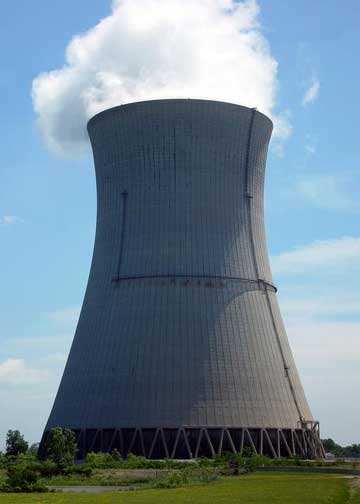 by Preston MacDougall April 21, 2006
I jest, of course. Global warming is not something to be taken lightly. Still, except for the Ghostbusters part, the light-hearted opening to this commentary captures my initial reaction to some surprising, and very welcome, developments in the environmental movement.
What has put me in such a good mood for Earth Day this year? I recently learned that Patrick Moore, a prominent environmentalist, has joined the growing chorus of those who argue that, among currently available technologies, nuclear energy is one of the most environmentally responsible ways to meet the planet's enormous energy needs. Its main benefit is that it does not produce any greenhouse gas emissions. Moore earned a Ph.D. in ecology from the University of British Columbia, shortly after he co-founded Greenpeace in 1971. Initially formed as a Canadian movement to non-violently protest both the building of nuclear energy power plants (that was the "green" part) and the testing of nuclear weapons (that was the "peace" part), this organization went global during the '80s. Around this time, I recall listening to another member of this organization on the radio. Ontario was then considering expanding its nuclear power program, and listeners were told, as accurately as I can recall, that "there was no way in Hell that scientists could ever convince (him) that the electricity from a nuclear power plant, going through (his) toaster, didn't contain left-over radioactivity." That was at least 20 years ago, but some things just stick with you - like the smell of burnt toast. Nuclear power plants do have very serious safety concerns, as the operators of the Soviet-style reactor at Chernobyl confirmed, but radioactive toast is not one of them. The reactions of many activists, but thankfully not all, to topics such as nuclear energy tend to be more superstitious than rational. Once an opinion is formed about "nukes", that's it. It can never change. It's a bogeyman. Rational responses require updated, and correct knowledge. That applies to everybody; those who are for a particular technology, and those who are opposed to it. For instance, during his recent trip to India, President Bush was wrong when he said that "Obviously, (nuclear) power is a renewable source of energy." Aside from the mispronunciation, he was mistaken; it is not. Nuclear fuel, which takes the form of uranium oxide pellets, is obtained from uranium ores just as iron is obtained from iron ore. Neither are "renewable" but the latter is much more abundant. Most nuclear energy power plants derive their energy from the highly energetic nuclear disintegrations, or "fissions", of radioactive uranium-235 nuclei. The chemical properties of this type, or "isotope", of uranium atoms are the same as for other uranium isotopes. For instance, they all form minerals containing the uranyl ion, which has a yellowish color and the chemical formula UO2+2. It is the radioactivity and the mass of the atomic nuclei that crucially differ. All uranium isotopes are radioactive, but under certain conditions U-235 is capable of sustaining a chain reaction of nuclear disintegrations, which can release enormous amounts of energy. This energy is then used to generate electricity, which is no more radioactive than the electricity generated by the hydroelectric generator at Niagara Falls is wet. The mass difference is what matters during the "enrichment" process, which has been the big story in Iran lately. Over 99% of the uranium atoms that are found in naturally occurring minerals are U-238 atoms, which will slowly decay until they reach the non-radioactive chemical identity of lead-206. Only 0.7% are U-235 atoms. The slower diffusion of slightly heavier gaseous uranium-238 hexafluoride molecules allows the separation of isotopes. Depending on the intended use of the uranium fuel, it may have to be enriched in the percentage of U-235 atoms. The CANDU reactors designed in Canada operate with natural abundance. Since no enrichment is required, this simplifies the security concerns surrounding such reactors. Most other power plant designs require about 3% abundance of U-235, and a nuclear weapon requires enrichment to 90% or more. Research is the only way to separate fact from fiction, and the internet is an excellent technology for the efficient diffusion of knowledge. If you want to celebrate Earth Day this year by doing a little research of your own, visit www.greenspirit.com. There you will find Patrick Moore's view of environmentalism in the 21st century. In a word: Good.
Publish A Letter on SitNews Read Letters/Opinions Submit A Letter to the Editor
|
||
